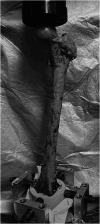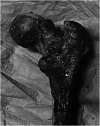The central collinear start point in femoral reconstruction nailing decreases ultimate failure load of the femoral neck: a cadaveric biomechanics study
- PMID: 40510400
- PMCID: PMC12160738
- DOI: 10.1097/OI9.0000000000000409
The central collinear start point in femoral reconstruction nailing decreases ultimate failure load of the femoral neck: a cadaveric biomechanics study
Abstract
Objectives: To compare the ultimate and relative failure loads of the femoral neck after insertion of a reconstruction nail through either the central collinear start point or the piriformis start point.
Methods: Twelve bilateral cadaveric femur pairs were assigned to either the central collinear (CC) group or the piriformis fossa (PF) group with an effort to match age distribution, sex, and bone mineral density between the 2 groups. All left femora were used as the surgical specimen, and all right femora were used as their respective intact controls. After insertion of a femoral reconstruction nail through the assigned starting point, each surgical femur underwent axial loading in line with the mechanical axis on a servohydraulic mechanical testing system until the ultimate failure load at the femoral neck was recorded.
Results: The ratio of the surgical femora ultimate failure load to the control failure load was 0.628 (SD = 0.072) for the CC group and 0.895 (SD = 0.064) for the PF group. A linear mixed effects model that used control versus CC versus PF group as the main effect and bone mineral density as a covariate yielded significant differences in ultimate failure load between intact controls and the CC surgical femora (P < 0.001) and between CC and PF surgical femora (P = 0.002). However, the model found no significant differences between the intact controls and the PF surgical femora (P = 0.597).
Conclusions: The central collinear start point reduces the ultimate failure load of the femoral neck compared with the intact femur and the piriformis fossa start point despite testing the instrumented femora with a femoral reconstruction nail including 2 femoral neck screws in place. However, there is no significant decrease in ultimate failure load with the piriformis fossa start point compared with the intact femur.
Keywords: biomechanics; central collinear; femoral reconstruction nailing; piriformis fossa.
Written work prepared by employees of the Federal Government as part of their official duties is, under the U.S. Copyright Act, a “work of the United States Government” for which copyright protection under Title 17 of the United States Code is not available. As such, copyright does not extend to the contributions of employees of the Federal Government.
Conflict of interest statement
The authors declare no conflict of interest.
Figures







Similar articles
-
Biomechanical Evaluation of the Risk of Subtrochanteric Fracture After Femoral Neck Fixation in a Synthetic Model: The Femoral Neck System versus Cannulated Screws.J Am Acad Orthop Surg. 2025 Aug 29. doi: 10.5435/JAAOS-D-25-00469. Online ahead of print. J Am Acad Orthop Surg. 2025. PMID: 40911846
-
Biomechanical evaluation of a central collinear entry reconstruction nail for femoral neck fracture prophylaxis.Injury. 2024 Aug;55(8):111640. doi: 10.1016/j.injury.2024.111640. Epub 2024 May 29. Injury. 2024. PMID: 38823097
-
Unlike Acetabular Anteversion, Femoral Anteversion Is Not Associated with the Hip Coronal Morphotype: An Anatomic Basis for a New Hip Morphotype Classification at Total Hip Arthroplasty.J Bone Joint Surg Am. 2025 Apr 28;107(12):1333-1341. doi: 10.2106/JBJS.24.00489. J Bone Joint Surg Am. 2025. PMID: 40294145
-
Assessing the comparative effects of interventions in COPD: a tutorial on network meta-analysis for clinicians.Respir Res. 2024 Dec 21;25(1):438. doi: 10.1186/s12931-024-03056-x. Respir Res. 2024. PMID: 39709425 Free PMC article. Review.
-
Global Delphi consensus on treatment goals for generalized pustular psoriasis.Br J Dermatol. 2025 Mar 18;192(4):706-716. doi: 10.1093/bjd/ljae491. Br J Dermatol. 2025. PMID: 39844356
References
-
- Garnavos C, Peterman A, Howard PW. The treatment of difficult proximal femoral fractures with the Russell-Taylor reconstruction nail. Injury. 1999;30:407–415. - PubMed
-
- Smith JT, Goodman SB, Tischenko G. Treatment of comminuted femoral subtrochanteric fractures using the Russell-Taylor reconstruction intramedullary nail. Orthopedics. 1991;14:125–129. - PubMed
-
- Starr AJ, Hay MT, Reinert CM, et al. Cephalomedullary nails in the treatment of high-energy proximal femur fractures in young patients: a prospective, randomized comparison of trochanteric versus piriformis fossa entry portal. J Orthop Trauma. 2006;20:240–246. - PubMed
-
- McMaster WC. Closed insertion technique for the prebent Sampson femoral rod. Clin Orthop Relat Res. 1979;138:238–242. - PubMed
-
- Winquist RA, Hansen ST, Clawson DK. Closed intramedullary nailing of femoral fractures. A report of five hundred and twenty cases. J Bone Joint Surg Am. 1984;66:529–539. - PubMed
LinkOut - more resources
Full Text Sources
